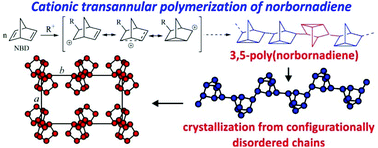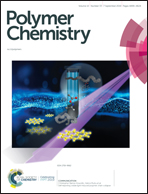Synthesis, chain conformation and crystal structure of poly(norbornadiene) having repeating 3,5-enchained nortricyclene units†
Abstract
The synthesis of a poly(3,5-tricyclo[2.2.1.02,6]heptylene) [poly(norbornadiene) (PNBD)] mediated by the TiCl4/Et2AlCl catalytic system is reported. This polymer is characterized by a rigid nortricyclene repeating structure and unique 3,5-enchainment and is obtained through a transannular cationic polymerization of norbornadiene involving both double bonds. The new PNBD is crystalline with high glass transition and melting temperatures due to the rigid tricyclic repeating structure. 13C NMR spectra indicate that the chains of PNBD contain only exo/exo (xx) and exo/endo (xn) nortricyclene repeating monomeric units. Models of the chain conformation and crystal structure of PNBD are also reported. Models of low conformational energy of isotactic and syndiotactic chains of PNBD have been obtained from the regular enchainment of xx and xn units. The model of the isotactic (xx)m chain with s(2/1) helical symmetry assumes a nearly trans-planar conformation, whereas the models of the syndiotactic (xn–xn)m and (nx–xn)m chains with tc and ti symmetries, respectively, assume the conformations (TG−G−TG+G+)n and (G−TTTG+T)n, respectively. Ideal limit ordered models of the crystal structure have been obtained from the X-ray powder diffraction data and the conformational energy analysis. A good agreement between experimental and calculated powder diffraction profiles has been obtained for a limit ordered model of packing of syndiotactic chains (nx–xn)m of PNBD with ti symmetry in an orthorhombic unit cell with axes a = 6.6 Å, b = 11.0 Å, and c = 6.84 Å according to the monoclinic space group P21/c. The real crystal structure of PNBD is disordered because of the possible presence of configurational disorder in the chains due to possible random enchainment of nortricyclene monomeric units in the xx, xn and nx configurations that produces conformational and packing disorder.



 Please wait while we load your content...
Please wait while we load your content...